The same day Napoleon entered Vienna, as the French Danube army under Napoleon and the Army of Italy under Eugene marched east, the Austrian Tyrol strategic position changed following the dramatic Bavarian success at Worgl (May 13th). FML Chasteler’s regular army reserve was shattered, the Tyrol mountainous region threatened more than ever and from different directions, and the Tyrol capital Innsbruck abandoned. The Bavarians completely cleared Napoleon’s line of communications Danube River basin issues within the course of a week after their victory at Worgl. FML Chasteler’s ability to remain in the Tyrol was questionable, especially after the Army of Inner Austria’s defeat at Tarvis (May 17th) and quick retreat towards Graz. The debacle and loss at Worgl marked renewed bitter recriminations between the Tyrolian insurgents and Habsburg regulars while the cycle of ferocious inhumanity of unchecked guerilla warfare, Bavarians burning and looting villages while Tyrolians murdered isolated soldiers continued.
FML Chasteler, disheartened and unsure after his defeat at Worgl, along with the constant abuse suffered from the hands of the erstwhile Tyrolian allies, fled to the Brenner Pass region. FML Chasteler, a veteran of many engagements and wounded on many occasions in Habsburg service, but now for several days lost his composure, sending out contradictory orders to his baffled General Buol commanding his rearguard position below Innsbruck. Orders from Archduke Johann helped little, he was on his own, and with little information regarding current European and military events outside of the Tyrol region. Oscillation between dejection and elation ensued, with FML Chasteler even assigning temporary command to General Buol as his battalions marched and counter marched the mountainous countryside roads. Finally, FML Chasteler firmly resumed command on May 21st and decided to leave the Tyrol region with the bulk of his remaining regular and landwehr corps.
The Bavarian division under General Wrede, after occupying Innsbruck along with the forces of Bavarian General Deroy, were ordered out of the Tyrol by Napoleon and General Lefebrve. Napoleon instructed Lefebrve to return to Salzburg with Wrede’s division, to defeat and pursue the roaming forces of FML Jellacic since, in his view, the Tyrol had been completely submitted to Bavarian control. Lefebrve and Wrede’s forces left the Tyrol region for Salzburg, eventuality marching to control the French army’s line of communications along the Danube River, leaving General Deroy alone at Innsbruck. The Tyrolians, under command of Andreas Hofer and others, quickly thought otherwise.
General Deroy, isolated and vulnerable in Innsbruck, soon had the renewed Tyrolian insurgent revolt “coming down the mountain sides”. The battles of Second and Third Berg Isel followed, both ferocious and costly, neither side gaining a decisive advantage, even with the Tyrolians outnumbering the Bavarians two to one. Deroy’s situation was hopeless. Surrounded in the centre of a hostile land at the end of a mountainous unguarded supply line, he had no choice but retreat. By the last days of May his Bavarian division had slipped back to Kufstein fortress. The Tyrol again was generally free from Bavarian occupation.
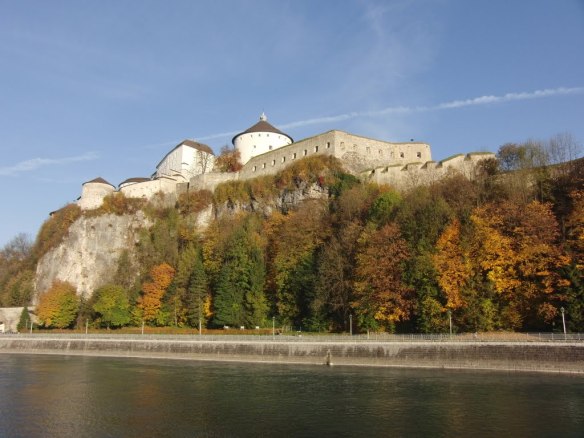
Kufstein fortress from the river view. Besieged by the Tyrolian insurgents and small detachments of Chasteler’s regular corps at various times during 1809 Tyrol revolt. Photo by Lugge.
While the Tyrolians, with some help from the few regulars left under General Buol, engaged then chasing the Bavarians under Deroy out of Tyrol, the Austrian regulars and landwehr under FML Chasteler marched mountainous roads east, attempting to join forces with Archduke Johann and the Army of Inner Austria. As Chasteler marched, his leading elements came into contact with the Italians under GD Rusca. Rusca, charged with protecting the Army of Italy’s line of communications and observing Chasteler’s Tyrol command, had marched along the southern mountain valleys of northern Italy and into Inner Austria. He reached Spittal on the 23rd of May, where he sent the Istrian battalion westward to Sachsenburg. Outside Sachsenburg skirmishing flared on the 24th and 25th of May as the lead elements of FML Chasteler’s army arrived slowly after march delays caused from destroyed bridges.
The destroyed bridges were the result of detachment GM Schmidt and his interaction with a small force of Italians (two weak battalions) under Colonel Moroni. Colonel Moroni had marched the 2nd Dalmatian battalion along with four companies of the 3rd Italian Legere from Osoppo, northward across the Plocken Pass towards GM Schmidt in Oberdrauburg. GM Schmidt, true to his later behavior at Klagenfurt, panicked from the wild rumors as given fact, destroyed all the local bridges between Oberdrauburg and Sachsenburg as a precaution. Common sense soon returned but the damage delayed FML Chasteler’s eastward march towards Spittal, finally entering that town on June 2nd. As for the force under Colonel Moroni, oblivious to his effect on local Habsburg morale, it reached Villiach on May 29th, and pressed on to join the Army of Italy near Raab mid June. GD Rusca was sorry to see those potential reinforcements depart the Drava river valley.
GD Rusca, learning that FML Chasteler was approaching Spittal, retired first towards Villiach on June 1st then on to Klagenfurt on June 4th. Arriving at Klagenfurt, he spent June 5th bolstering the old city wall defenses and collected local grain and food stuff in preparation of a possible siege. Writing to GD Marmont requesting support, he planned an active defense at Klagenfurt, knowing full well that Marmont was too far away to arrive before Chasteler’s small army encamped outside the walls of Klagenfurt. As for FML Chasteler’s motives, he simply wanted to escape past Klagenfurt and rejoin Archduke Johann and the Army of Inner Austria.
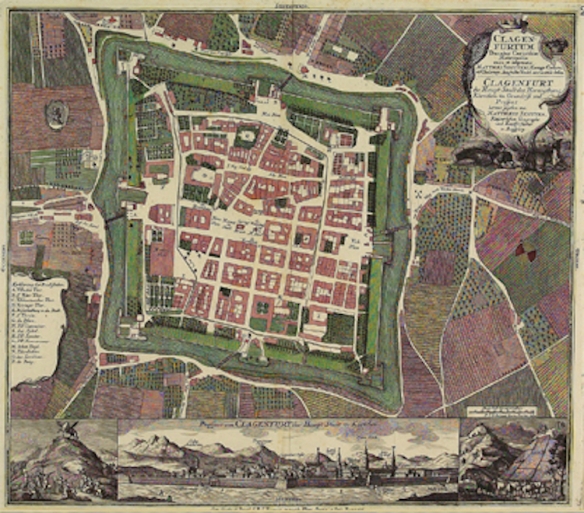
Klagenfurt map circa 1735 showing the street layout, fortress walls, city gates, and moat around the city. Few buildings outside the fortress walls at this period unlike the 1809 battlefield.
Klagenfurt was a small walled town in 1809, square in outline with old fortress walls, a water filled moat fed by the Lend Kanal, and some developed built up outskirts surrounding the town. Situated in a broad valley encircled by rugged hills, Klagenfurt had the Glan River just to the north of town and the Lend Kanal waterway out west towards the Worther See. Klagenfurt was an important crossroad town for north-south and east-west commercial traffic. FML Chasteler was relying on the east-west highway to link with Archduke Johann, but first had to pass the Franco-Italians under GD Rusca in Klagenfurt. Delaying his march before Klagenfurt or risking a major engagement was not FML Chasteler’s intentions. Therefore Chasteler planned to mask the town exit points, keeping Rusca inside Klagenfurt while his small corps and its baggage trains slipped past south of Klagenfurt regaining the eastern highway beyond Klagenfurt.
Pre-dawn hours of June 6th saw the Austrian forces march quietly south and around the city walls using secondary roads. The Advance guard (under Major Lachovsky) positioned themselves near St. Peter after detaching individual “tripwire” fusilier line companies from IR #26 Hohenlobe-Bartenstein at the western, southern and eastern (Volkermarkt) fortress gates. The balance of the Austrian forces were positioned in three unsupportive groups (outlined below). GM Schmidt commanded his group southwest of Klagenfurt while newly promoted Oberst Volkmann commanded another group on the heights of Kalvarienberg. The final group marched south to destroy the Drawa River bridge and watch towards Laibach at the Loibi Pass since FML Chasteler intercepted several dispatches between Rusca and Marmont indicating possible French reinforcements via the Loibi Pass.
Advance Guard (Lachovsky):
2nd Banal Grenz – three companies, Hohenzollern Chevaulegers #2 – 1 sqn., 9th Jagers – one company, two unknown Landwehr detachments.
Main body (GM Fenner and GM Marcal):
IR #26 Hohenlohe-Bartenstein – 1 2/3 battalions, Hohenzollern Chavaulegers – 1 sqn., 1st Villach Landwehr, 1st, 2nd, and 3rd Klagenfurt Landwehr, 2nd Bruck Landwehr, mixed light artillery (5). Corps military train and most baggage with Main body.
Oberst Volkmann group:
IR #53 Johann Jellacic – 1 2/3 battalions, Hohenzolern Chevaulegers – 1 sqn., small 3 pdr half battery or battalion cannon (3).
GM Schmidt group:
IR #52 Franz Karl – one battalion, 2nd Banal Grenz – four companies, Luis Schutzen freikorps – one company, Hohenzollern Chevaulegers – 1 sqn., some battalion cannon (2).
Detached group to south:
IR #26 Hohenlohe-Bartenstein – two companies and pioneers.
Delayed baggage guard near St Martin:
2nd Banal Grenz – two companies.
Plus the “tripwire” detached fusilier companies from IR #26 Hohenlohe-Bartenstein facing the fortress exit gates. Approximate Austrian army about 9,000 men vs. the Franco-Italians numbering around 5,000 men as accurate field strength is unknown. The Franco-Italian roster is presented in the scenario notes.
Battle of Klagenfurt:
As sunny daylight basked the summertime Klagenfurt plain, the Austrian Main body and train slowly headed for St Peter via St Ruprecht. Suddenly the units of GM Schmidt’s command were surprised by rapid Franco-Italian assaults from Klagenfurt fortress gates. The tall crops completely hid Rusca’s battalions advancing at the defending Austrians positioned in the open fields between Weidendorf and St Ruprecht. Sharp combat completely scattered the Luis Schutzen freikorps company near the Villach gate, local boys from Klagenfurt followed by the rout of IR #52 Franz Karl and the 2nd Banal grenz companies. GD Rusca, by contrast, had mounted the southwest Marienkirche tower (in Klagenfurt) to afford himself a clear view of the Austrian dispositions, and communicated unusual command and control by dropping his weighted written instructions to waiting impatient orderlies.
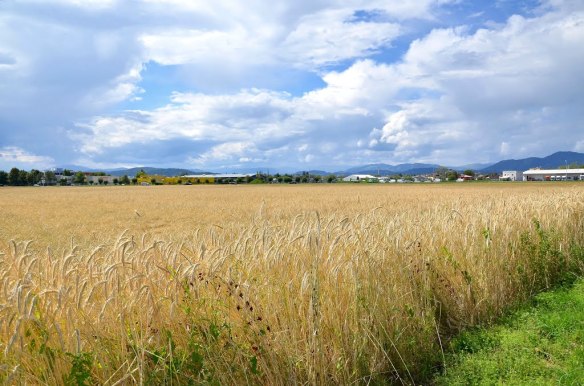
Crop fields outside of Klagenfurt. Shorter modern crops vs. the tall hybrids of the early 19th century.
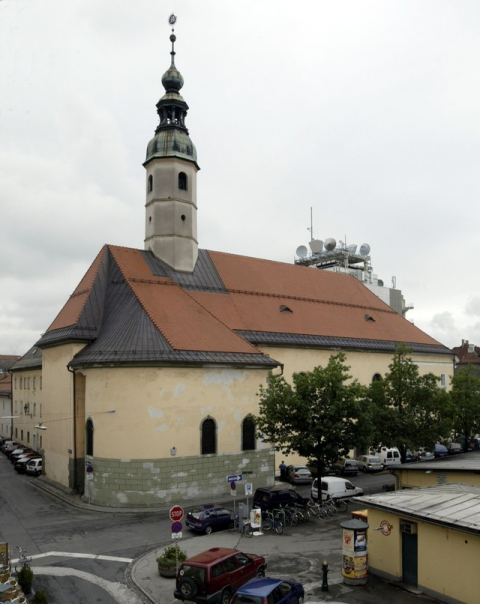
Marienkirche in Klagenfurt. the tower is probably the same which General Rucca observed the Austrian positions.
By 2 pm, with the Austrian train moving into St Ruprecht and crossing the Stadt Kanal drainage ditch, Austrian battalion commanders were trying to rally the westward fleeing units of GM Schmidt’s small command. GM Schmidt, suffering from migraine headaches preventing him mounting his horse, made the decision to direct the retiring IR#52 Franz Karl battalion towards Oberst Volkmann’s stationary command on the wooded and steep Kalvarienberg. Soon afterwards changing his mind he orders all his retiring units plus Oberst Volkmann’s command to leave the battlefield westward back towards Vallach. Reading the orders Oberst Volkmann outright refused and with the surviving companies of IR #52 Franz Karl now on the heights, proceeded to defend the Kalvarlenberg. GM Schmidt’s personal flight encounters the 2nd Banal Grenz detachment (two companies) guarding some baggage trains separated from the main body. He orders them and the remains of his command, less the IR#52 Franz Karl battalion, to march with him back into the mountains of Tyrol, vanishing from FML Chasteler’s command and known whereabouts for several days. After the 1809 campaign, GM Schmidt actions at Klagenfurt subjected him to a Habsburg military court of inquiry. He ended his distraught life before the final inquiry proceedings were heard.
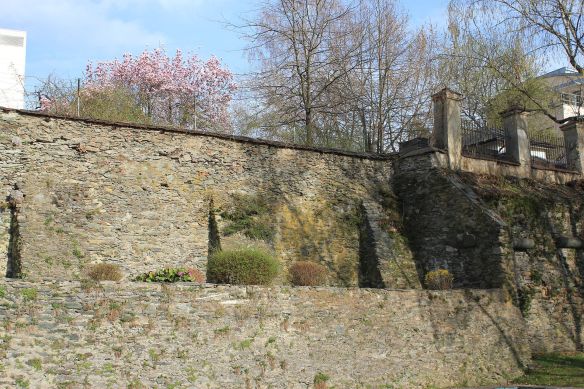
Part of the western Klagenfurt city wall, behind which GD Rusca reformed his infantry for the renewed assault on the Kalvarienberg and Oberst Volkmann.
Oberst Volkmann now found himself with the personal attention of GD Rusca. Returning back into Klagenfurt, Rusca reformed his now “tasted battle” conscripts and sortied again from Klagenfurt gates towards Oberst Volkmann’s Kalvarienberg position. Rusca wanted to clear any Habsburg force overlooking the city of Klagenfurt before dusk, thus remove and defeat the command of Oberst Volkmann. The French and Italian recruits showed great courage struggling up the steep Kalvarienberg slopes under Austrian musketry and battalion cannon. Oberst Volkmann rallied and led his men skillfully against every French or Italian thrust up the hill, repelling them all. Losses continued mounting for both sides till dusk ended the fighting on the bloody slope. Having saved Habsburg honor holding his ground on the Kalvarienberg, Oberst Volkmann small command quietly slipped away during the night hours and rejoined FML Chasteler’s forces around St Peter village and the Schloss Welzenegg.
Interesting part of the battle narrative is what happened with the detached IR #26 Hohenlohe-Bartenstein fusilier companies stationed outside the fortress gates? They gave no warning of the enemy advance by either musketry or running past the deployed units of GM Schmidt. Why the Hohenzolern Chevaulegers atop their mounts couldn’t see the approaching Franco-Italian battalions either?
Battle at Klagenfurt ended with mixed results for both sides. The Austrians successfully bypassed the Klagenfurt fortress with the majority of FML Chastler’s corps, including the supportive baggage and artillery left over from the disaster at Worgl. Only the defeat of GM Schmidt’s small command and his inglorious flight tainted the Austrian performance. For GD Rusca, he held his position in Klagenfurt, kept the small conscript Franco-Italian division intact, and gave the Habsburg force “a black eye” defeating GM Schmidt. Austrian losses totaled about 850 men while Rusca’s Division suffered 350 on the battlefield.
FML Chasteler continued his march east and arrived in Warasdin on June 15th. By the end of June he was with GM Mesko at Szent Groth west of Lake Balaton and finally joined Archduke Johann after Wagram near Tet on July 17th, just in time for the armistice between Archduke Charles and Napoleon which ends the 1809 campaign.
Scenario notes for playing Klagenfurt on the tabletop (.doc): Klagenfurt Scenario notes
Klagenfurt 1809 scenario rosters (.xls): Klagenfurt 1809 Austrian roster, Klagenfurt 1809 Franco-Italian roster
Update: Klagenfurt AAR written and posted: Klagenfurt 1809 AAR
After the 1809 campaign Napoleon, per the terms of peace with Austria, required several of the older Austrian fortress to have their wall razed to weaken the interior Austrian provincial defenses. Klagenfurt WR understands was one of those named old fortresses. The fortress walls were generally razed but the old fortress gates remained to control entrance into the city (collect tolls etc). Even these were finally razed in the 1890’s as the city grew beyond the old civic walls.

St Martin bridge over the Lend Kanal west of Klagenfurt. Basically un-crossable from the wargaming viewpoint except at the bridges.
Really only one solid english source for this battle that WR is aware of. That is, of course John Gill’s book 1809 Thunder on the Danube Vol. III (lower right in photo below). The other books give only a brief passing on this engagement but do mention the events of the 1809 campaign.
Note: Seen various spelling of Tyrolian, Tyrollean and Tyrolean spelling in several books and on internet. Which is it? I followed John Gill’s example and use of “Tyrolian” but WR open for comment.
Cheers from the warren.
P.S. A photographic peak at the WR’s fortress. Soon to be upgraded with nice paper brickwork, new fortress gates, cobblestone interior ground texture, and a full complement of fortress carriage bastion cannon. Future blog report indeed on construction and the final look staged in my future Klagenfurt scenario game AAR.
Update: Generic Vauban style fortress construction and brickwork post link: Fortress

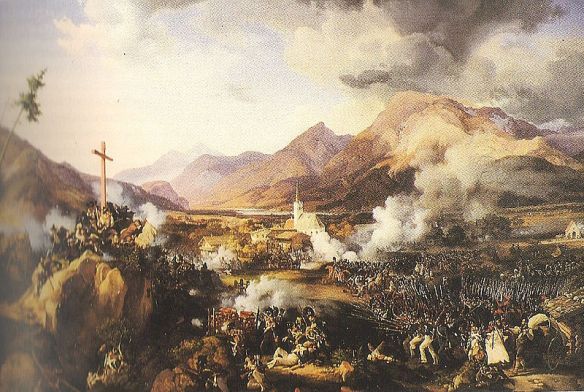
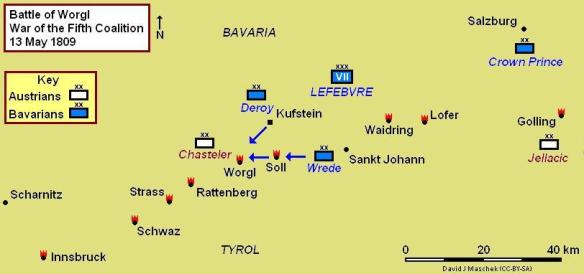
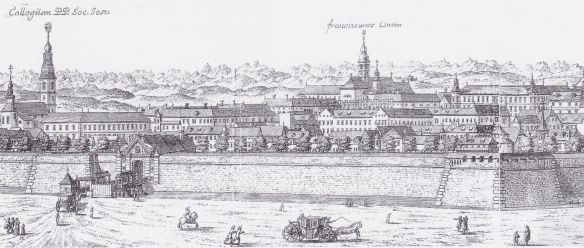
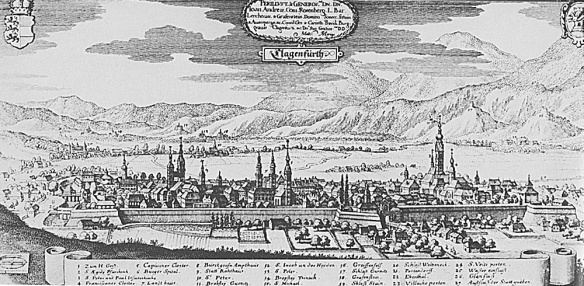
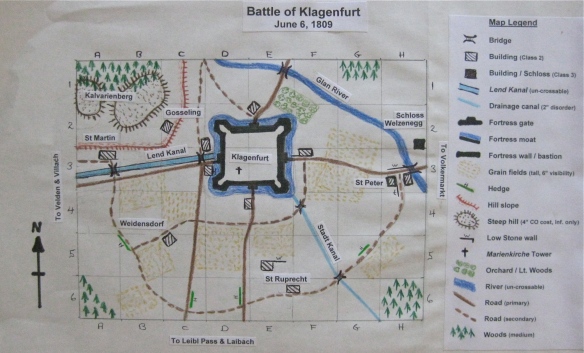
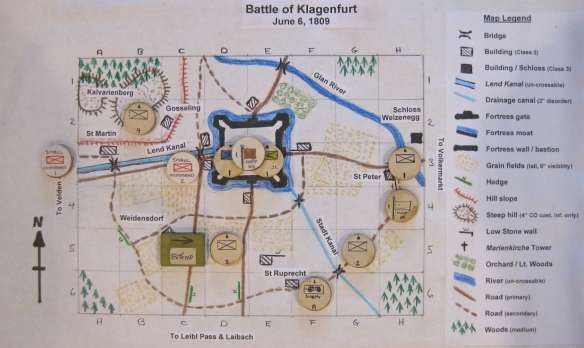
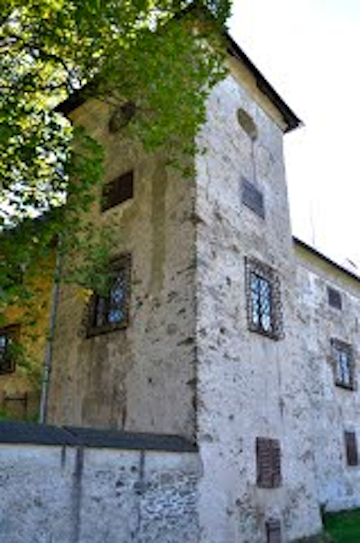
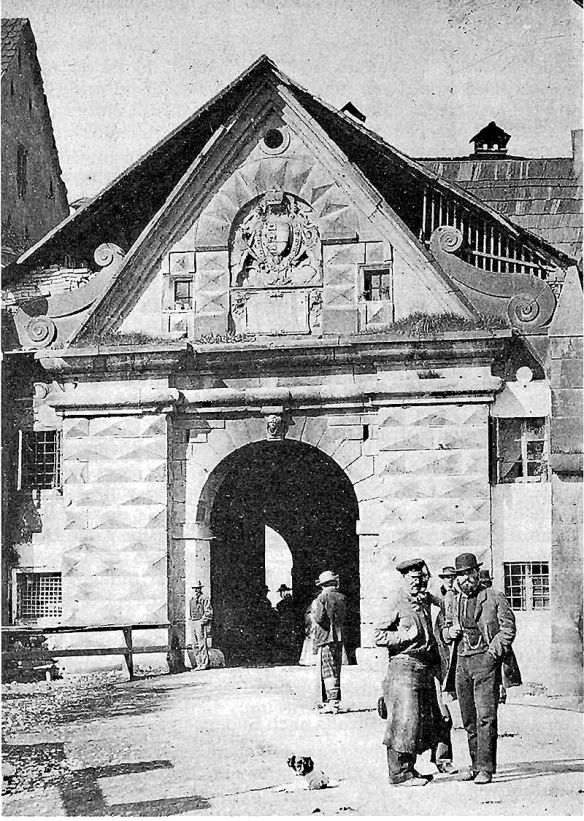
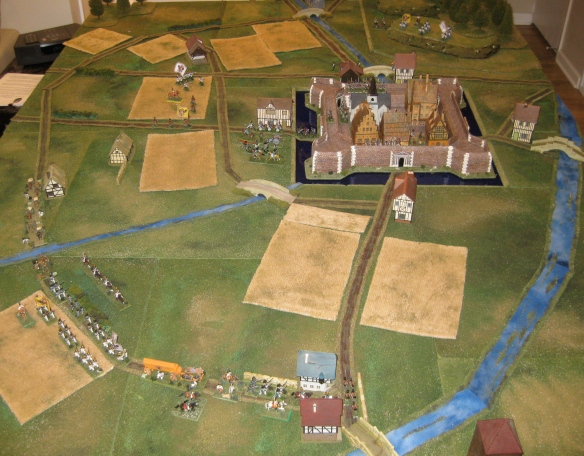
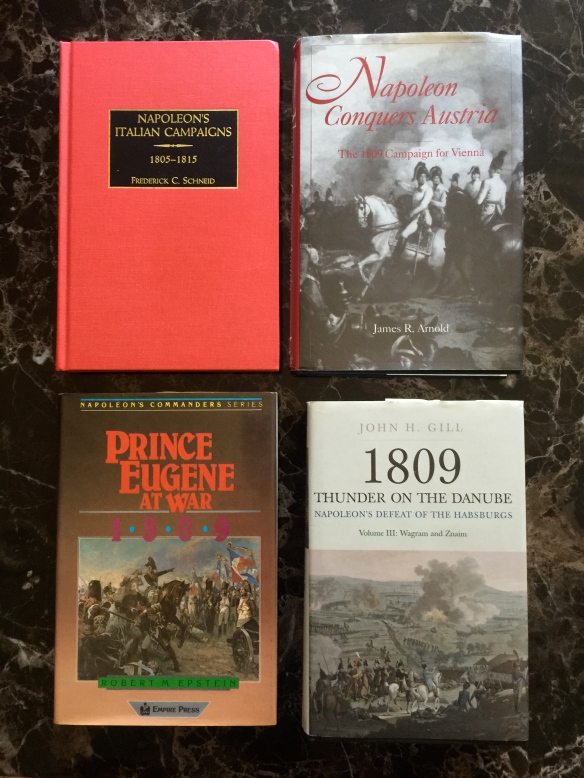

Great background and set up for a very unusual action. Sorry I haven’t been around to comment sooner. The Fortress in the raw is looking excellent already, too!
Welcome back to warren Peter. Cannot wait to finish the fortress (future blog article on construction), as the walls are now covered in brickwork. Then see if the Klagenfurt scenario works. If so… another AAR in the print hopper.
M